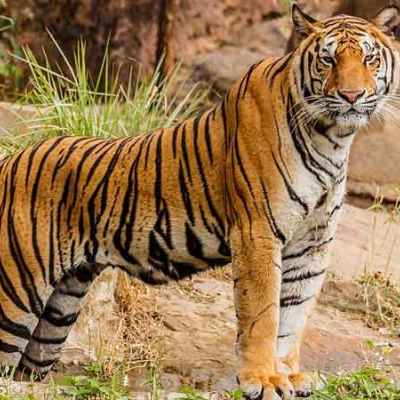KMTR is the only one tiger reserve in Tamilnadu and 17th tiger reserve in India. This was established in the year 1988.

This reserve is a mixture of three main sanctuaries Kalakad Sanctuary and Mundanthurai Sanctuary and a part of Kanyakumari Sanctuary. It sprawls across an area of 895 Sq.KM. This Reserve has been identified as one among the Type-1 Tiger Conservation Units (TCU) and also classified as tropical moist evergreen forests.
This sanctuary is located in the midst of latitudes 80 25’ North to 80 53’ North, between longitude 770 10’ East and 770 35’ East, this sanctuary also forms a part of Agasthiyarmalai Biosphere Reserve. This sanctuary receives rainfall on both the monsoons and so it can be found greenish all time.
Important species include significant Sarcandra, a vessel less Angiosperm, Paphiopedulum, druryi, a rare orchid and Nageia wallichiana a broad leafed and only conifer tree of south India. Other important tree species include Hopea parviflora, Hopea utilis, Calophylum elatum, Cullenia exarillata, Artocarpus hirsute, Syzygium sp., Cinnamomum zeylanicum, macaranga roxburghii, Mesua ferrea, Gluta travancorica, Canarium strictum, Veteria malabarica, Myristica species and ect.
Fish:
This sanctuary is blessed with lots of waterbodies and so many varieties of water creatures can be found including Glossogobius giuris, Mastacembelus armatus, Channa striatus, Channa orientalis, Etroplus maculatus, Etroplus suratensis, Oreichormis mossambica (Tilapia mossambica), Macrones vittatus (Macrone vittatus), Ompak bimaculatus (callichrous bimaculates), Heteropneutes fossilis (saccobranchus fossilis), Xenentodon cancila (Belone cancila), Aplocheilus lineatus (Haplochilus rubrostigma), H.lineatus synonym of Aplocheilus lineatus, Bhavania australis (Homaloptera brucei), bengalensis and ect.
Adding to this about 89 varieties of Amphibians, reptiles, endemic species and non-endemic species are found. 30% of the reptiles are considered to be poisonous.
Birds:
This sanctuary is a home to lakhs of birds’ species. As this sanctuary has dense tree and lush forest, it is a safe haven for many lovely birds. Few of the notable ones are Grey Francolin, Rain Quail, Jungle Bush Quail, Small Buttonquail, Yellow-legged Button quail, Barred Button quail, Red Spurfowl, Painted Spurfowl, Grey Junglefowl, Indian Peafowl, Bar-headed Goose, Lesser Whistling-duck, Cotton Pygmy-goose, Spot-billed Duck, Northern Pintail, Eurasian Wryneck, Speckled Piculet, Rufous Woodpecker, White-bellied Woodpecker, Brown-capped Pygmy, Woodpecker, Lesser Yellownape, Streak-throated Woodpecker, Common Flameback, Black-rumped Flameback, Greater Flameback, Brown-headed Barbet, Forest Wagtail, White Wagtail, White-browed Wagtail, Yellow Wagtail, Grey Wagtail, Nilgiri Pipit, Paddyfield Pipit, Baya Weaver, Indian Silverbill, White-rumped Munia, Black-throated Munia, Scaly-breasted Munia, Black-headed Munia, and Common Rosefinch. The visitors can see birds feeding their small ones at a hand’s distance
Mammals :
Mundanthurai is also a safe haven for more than 79 species including Tiger, Asian Elephant and Lion tailed Macaque. The co-predators of Tiger include wild-dog or Indian Dhole and Leopard.
Other species are: Madras hedgehog, Days’ shrew, Grey musk shrew, Hill (mountain) shrew, Pygmy shrew, Fulvous fruit bat, Indian flying fox, Lesser dog-faced fruit bat, Short-nosed fruit bat, Lesser mouse-tailed bat, Black-bear tomb bat, Pouch-bearing bat, Greater false vampire, Lesser false vampire, Rufous horseshoe bat, Blyth’s horseshoe bat, Lesser woolly horseshoe bat, Dusky leaf-nosed bat, Fulvous leaf-nosed bat, Schneider’s leaf-nosed bat, Evening bat, Painted bat, Slender loris, Bonnet macaque, Lion-tailed macaque, Common langur, Nilgiri langur, Indian jackal, Bengal fox (from outside PA), Dhole or Asiatic wild dog, Sloth bear, Nilgiri marten, Common otter, Smooth coated otter, Oriental small clawed otter, Small Indian civet, Common palm civet, Jerdon’s (brown) pawn civet,
Common Indian mongoose, Brown mongoose, Ruddy mongoose, Stripe-necked mangoose, Leopard cat, Jungle cat, Rusty-spotted cat, Leopard, Tiger, Asian elephant, Wild boar, Indian spotted chevrotain or mouse deer, Barking deer, Chital, Sambar, Gaur, Nilgiri tahr, Indian pangolin, Common palm squirrel, Dusky striped squirrel, Jungle striped squirrel, Indian giant squirrel, Indian giant flying squirrel, Travancore flying squirrel, Malabar spiny dormouse, Indian gerbil, Indian bush rat, Soft-furred field rat or metad, White-bellied wood rat, Indian field mouse, Bonhote’s mouse, House mouse, Spiny field mouse, Indian long-tailed tree mouse, Lesser bandicoot rat, large bandicoot rat, Indian porcupine and hare
Medicinal plants
Mundanthurai forest department takes immense steps in planting medicinal plants all around the area. So far they have planted medicinal trees including Hibiscus, Emblica, Pomagranade, Tulsi, Vilvam etc in 150 ha. They have also distributed 36000 plants to the public at free of cost. . Moreover about 4000 seedlings have been planted in Agasthiar Kani Settlement, Servalar Settlement, Mundanthurai Forest staff quarters, Kani school buildings and Servalar Government Hospital building.
Biodiversity
KMTR is one among the 5 centers of plant diversity and endemism of India. It is considered as a richest conservative and so got the name “Super-hotspot”. The floral diversity in KMTR includes 448 endemic species, 58 Red- listed species, 601 Medicinal species, and 90 species of wild relatives of the cultivated plants. There are 3 Gymnosperms and 156 Pteridophytes. The faunal diversity includes 47 species of fish, 47 species of amphibians, 89 species of reptiles, 337 species of Birds and 79 species of Mammals
APPROACH
There are bus service from Tirunelveli, Thirukarangudi, and Kalakad. The nearest railway station is at Tirunelveli 50 kms. Airport service is available at Madurai 200 kms from Mundanthurai.